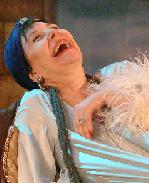SITE GUIDE
SEARCH
ADVERTISING AT CURTAINUP
REVIEWS
FEATURES
NEWS
Etcetera and
Short Term Listings
LISTINGS
Broadway
Off-Broadway
NYC Restaurants
BOOKS and CDs
OTHER PLACES
Berkshires
London
California
New Jersey
Philadelphia
Elsewhere
QUOTES
TKTS
PLAYWRIGHTS' ALBUMS
LETTERS TO EDITOR
FILM
LINKS
MISCELLANEOUS
Free Updates
Masthead
Writing for Us
A CurtainUp Los Angeles Review
The Milk Train Doesn't Stop Here Any More
| All cruel people describe themselves as paragons of frankness.— Mrs. Goforth |

Karen Kondazian in The Milktrain Doesn't Stop Here Any More
(Photo: ) |
This rarely performed, sometimes rambling meditation on the pros and cons of mortality is being presented in Los Angeles for the first time in 29 years. It's getting the best performance it's likely to have at the Fountain Theatre under the direction of Simon Levy, whose intuitive understanding of the playwright has earned him exceptional privileges from the vigilant Williams estate.
Set in a creamy-rose villa above the Mediterranean, bewitchingly designed by Travis Gale Lewis, it tracks the ferocious duel of seduction and destruction between Flora "Sissy" Goforth, the legendary beauty who is now a dying monster, and Christopher Flanders, a ravishing poet on the cusp of middle age who has become a professional visitor of dying old ladies, thus earning the title "Angel of Death."
The play's title comes from the demise of the train that carried milk in the old days and Sissy uses it as a metaphor for her own physical and financial largesse. Karen Kondazian as Sissy has the exceptional range to contrast the flamboyance, sensuality and power of an international celebrity with the vulnerability of a lonely child and Michael Rodgers catches the disillusioned spirituality of Christopher Flanders with dry gallantry. Chris, who climbs Sissy's mountain with the gift of a hand-made mobile and a ten-year-old volume of poems, is no easy lay. He wants a place to rest and work and get back his sense of reality. In return, he offers companionship but Sissy is used to calling the shots. She "can't stand to be made a Patsy" and is naturally suspicious of freeloaders—, "reasonably young people who used to be younger" She even resorts to denying him food in an attempt to get her way. The most terrifying moment in the play is when Chris asks for a cigarette and she commands him to kiss her for it. The expression Kondazian calls up is beyond evil; it's soulessly avaricious.
Williams isn't sentimental and he never lets Sissy accept Chris's belief that he brings what she needs, not what she thinks she wants. To the end, she rejects his gift of acceptance, giving him practical advice on his next seduction. Her final line, though a plea, is couched in her customary language of command.
The second act rambles more than necessary, especially since Williams seems to share Chris's nihilism. Chris repeats the sound of the wave —" Boom! No translation, no explanation, just Boom!"— as if it were a mantra. Though Sissy wants to write about the meaning of life in her memoirs, she can't and Williams can't do it for her.
The third inhabitant of Sissy's villa is her secretary, Frances Black called Blackie,whom Sissy taunts for her Vassar airs and her formal way of referring to her late husband. To Sissy's "The dead are dead and the living are living," Blackie retorts, "Not so, I'm not dead but not living!" As Blackie, Lisa Pelikan , looking like a young Deborah Kerr, gives the play a sense of balance, playing the audience's advocate with a yearning delicacy.
Sissy calls on her old girlfriend, now called The Witch of Capri, to vet Chris. A much-married piece of international flotsam, the Witch knows all about Chris but tries to lure him to her mountain anyway. He tells her, "You're the heart of a world that has no heart." Scott Presley downplays this part, perhaps intending to make her believable and avoid a vaudeville act in her scenes with the flamboyant Sissy. However, there should be a reason a character is called The Witch of Capri and Presley hasn't found it.
Rhino Michaels makes a menacing Rudy, the bodyguard, Lauren Silvi a pretty maid Simonetta and Dominic Acosta a vivacious Giulio.
Kathi O'Donohue's lighting design catches the golden light of the Divina Costiera and Shon LeBlanc's costumes range from perfect 1960s for Blackie to all the far-out theatricality a legendary beauty like Sissy could ask for, monstrous or not.
Though not vintage Williams, this play and this production have too many solid pleasures to be ignored.
|
THE MILK TRAIN DOESN'T STOP HERE ANY MORE Playwright: Tennessee Williams Director: Simon Levy Cast: Karen Kondazian (Mrs. Goforth), Lisa Pelikan (Blackie), Scott Presley, Travis Michael Holder (alternates) (The Witch of Capri), Michael Rodgers (Christopher Flanders), Dominic Acosta (Giulio), Lauren Silvi (Simonetta), Rhino Michaels (Rudy). Set Design: Travis Gale Lewis Lighting Design: Kathi O'Donohue Costume Design: Shon Le Blanc Sound Design: David B. Marling Hair & Make-Up Design: Judi Lewin Properties Design: John Minchin Running Time: Two hours 40 minutes, one intermission Running Dates: September 28-November 4, 2007 Where: The Fountain Theatre, 5060 Fountain Avenue, Los Angeles, Reservations: (323) 663-1525. Reviewed by Laura Hitchcock on September 28. |

Easy-on-the budget super gift for yourself and your musical loving friends. Tons of gorgeous pictures.

Leonard Maltin's 2007 Movie Guide

 >
>

